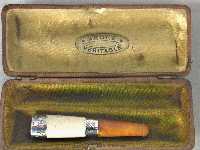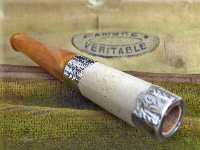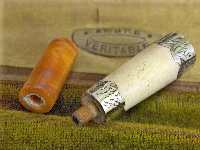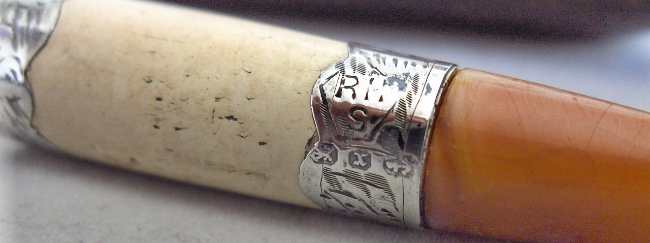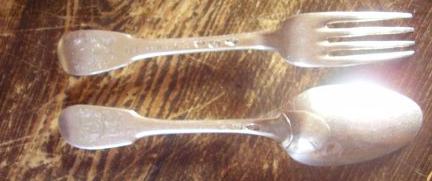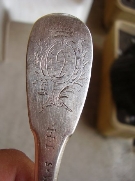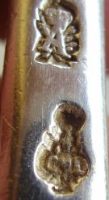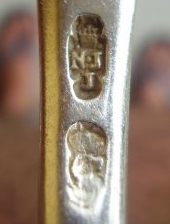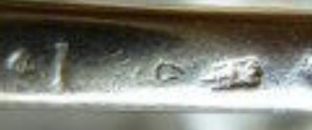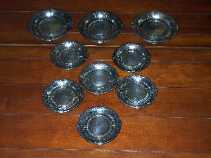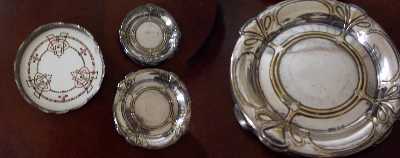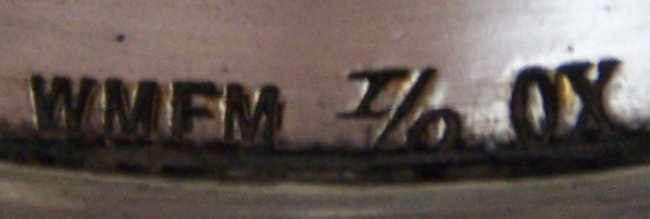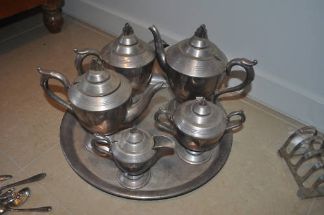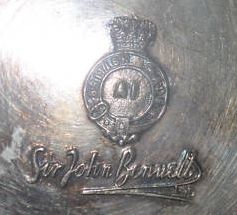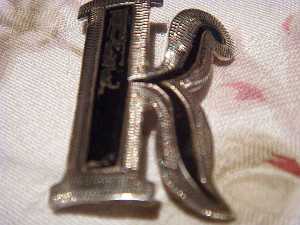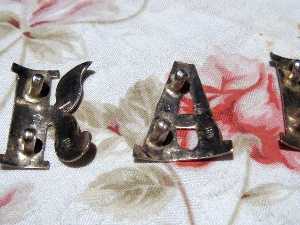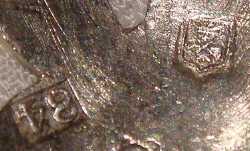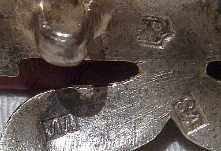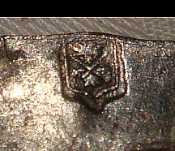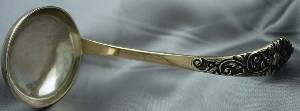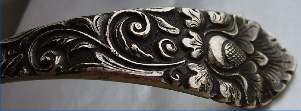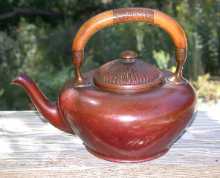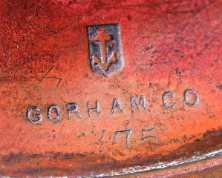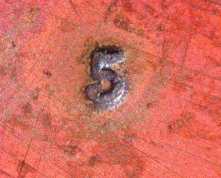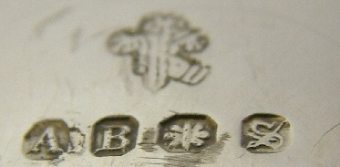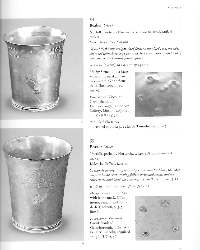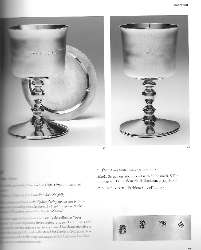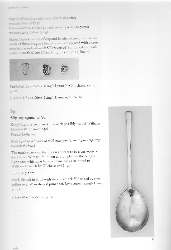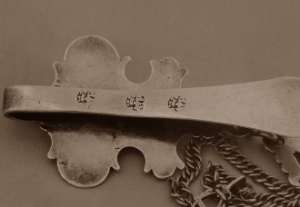
Lise Moor presents:
The triple master silversmith mark on French silver
artifacts: The marking of subscriber-masters under the
"Ancien Régime" (1672-1798) 
Le marquage par le maitres-abonnés sous l'Ancien
Régime: L'Empreinte du Maitre-Orfevre repetée trois fois
à l'exclusion de tout autre poinçon sur l'orfevrerie
française de 1672 à 1798) 
.....It is not rare for collectors and dealers to find
French silver artifacts of the 18th century bearing the
master silversmith mark repeated three times. When an
object bears only the master's mark repeated three times
(of the whole series of marks), usually the piece is
attributed to a subscriber-master ("Maître-Abonné")
....
click here  click here
click here 
|
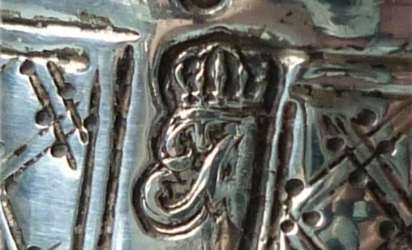
Christophe Ginter presents:
An imitation of Louis XV hallmarks (II) - The example of Paris, 1768-1774 
Une imitation de poinçons Louis XV (II) - L'exemple de Paris, 1768-1774 
.....Among the objects of the French "Ancien Régime", the
production of the long reign of King Louis XV (1722-1774) is the
most frequent victim of forgeries and fraudulent attributions.
This phenomenon, interesting particularly the furniture, widely
affects also the silverware, with a special predilection for the
prestigious production of Paris....
click here  click here
click here 
|
Welcome to new ASCAS members:
John Alejandro - USA
Linda Bryan - USA
Amanda Conran - USA
Norah Cooper - USA
Marsha M. Davis - USA
Netta Dobson - France
Bill Pirkle - USA
Madhuri Raavi - India
Leo van Retep - The Netherlands
Keith A. Saville - England UK
Members' Window # 78
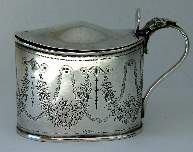
Robert Massart presents:
A Silver Mustard Pot - Birmingham 1906 
An Edwardian solid sterling silver mustard pot with
original cobalt blue glass liner, made in 1906 by the
famous silversmith William Aitken in his workshops 'Eagle
Works', 78 Summer Row Birmingham.
The body is hand chased with a decoration of garlands of
foliage and flowers. The domed hinged lid is raised by
means of a thumbpiece and the spoon aperture is cut in
the shape of a keyhole opposite the scroll handle. The
original Bristol blue glass liner is in perfect
condition and free of chips or flea bites....
click here 
|
Piero Eduardo writes:
... Caro Giorgio, recently I made another of my strolls among
the old and antique shops and flea markets and I found a case
with a mouthpiece made of pure amber, meerschaum and accessories
in silver. I was unable to find any reference about the maker (S
to RM in a Diamond??). Perhaps you can read something else? The
date is Birmingham 1897.
Do you have any information about this silversmith?
Ti ringrazio e saluto cordialmente
Piero
Caro Piero,
The mark is RHS (and not RMS). The makers are Robert, Albert and
Charles William Hovenden, trading as R. Hovenden & Sons. The
firm was active in 1894 at 91, 95 City Road, Finsbury, London
when the firm entered (as merchant) a mark (RH over S into a
lozenge) in Chester Assay Office. Another similar mark was
entered in 1900 in London Assay Office as R. Hovenden & Sons Ltd,
gold and silver workers.
Another mark (R.H & Ss Ltd into a rectangle) was entered in 1905
in Chester Assay Office, as R. Hovenden & Sons Ltd, 29/33
Berners Road and 89/95 City Road, London (general merchants and
warehousemen).
Cordiali saluti
Giorgio Busetto
Eddie Robinson writes:
... I have an egg cup, spoon and footed stand.br> It has the
initials [B1 in a shield][W][&][H][S] [SYMBOL] [W&H INSIDE A
FLAG]. I assume W&H is William Hall!
What does [B1] stand for, is it similar to A1?
What is the symbol after the 'S'
It seems that the hallmark "W&HS" were used between 1852-1897 is
this correct, or am I barking up the wrong tree?
Best regards.
Eddie Robinson
From Down Under
The maker is not William Hall but Walker & Hall,
Sheffield (see my web site at
http://www.silvercollection.it/electroplatesilverWZ.html ).
I believe that B1 is a quality mark (as A, A1 etc) while S was
used to indicate the town (Sheffield).
I recently realized a web page dealing with the meaning of
alphabetic symbols in British silver plate. The link is
available in the "A World per Month" column of this newsletter (see
below).
Giorgio Busetto
Haroune Toumani writes:
...I need help in the identification of the master silversmith
and date of these spoon and fork.
Any help will be welcome.
Haroune Toumani
Jayshree Desai writes:
... I would like to share this "Antique find" of mine with all
the members. These lovely Art Nouveau coasters are signed WMFM
I/o OX. It is in two tones. Silver & Gold. I was searching for
the meaning of WMFM on the Internet and came across this Silver
Association ASCAS. It is a very knowledgeable site. I hope every
one will enjoy my find. The larger coaster on the left is in
German silver with Art Deco design.
Thank you
Jayshree Desai
The "M" means "brass base". You can see this and other
information about WMF marks in Prof. Nikogosian article at
http://www.ascasonline.org/windowAGOST63.html.
Giorgio Busetto
Samantha Macnally writes:
... I hope you might be able to help me.
I purchased a silver? teapot/ coffee pot/ water pot/ sugar bowl/creamer
and tray that is marked "Sir John Benwell" Ltd on the
base of each item, with A1 in the centre of the base brand on
each item - and some writing saying "British Made" stamped into
the brand/ stamp/ trade mark.
I have polished it with Silver polish and it has come up
beautifully. And looks quite stunning.
Can you tell me anything more about the maker? Is it actually
silver - and if not, what metal would you suggest it is?
Thank you
Samantha Macnally
Your tea/coffee set is silver plate and not sterling or
solid silver.
This is what I found about the possible maker of your set: The
Trade mark is "Sir John Bennett" and not Benwell. The wholesale
business J.B. Bennett & Co Ltd was founded in London in 1907 by
John Baker Bennett.
In 1908 the firm, described as manufacturing jewellers, changed
its name to Bennett (1907) Ltd but was forced into voluntary
liquidation in 1909 and the goodwill and the stock-in-trade were
acquired by Fredericks Ltd. A sterling silver hallmark (SIR
J.B.Ltd) was entered in c. 1932 in the London Assay Office by
Sir John Bennett Ltd.
Presumably the trade mark "Sir John Bennett" was used by
retailer shops in the UK and, possibly, in Sydney (Australia).
Giorgio Busetto
The "belt" is a credible hypothesis. Any suggestion will
be welcome
Giorgio Busetto
Replies to questions
José Luis Muñoz writes:
... About the silver piece of Michael Smith I can confirm
that the mark is Spanish and refers to silversmith LOPEZ (LO -
PEZ). Pez in Spanish means "fish" and this justifies the
presence of a "fish" in the mark.
The silversmith is still active and further information is
available in his web site at http://www.platerialopez.es
Best regards,
José Luis
Shawn Holatko writes:
... In response to the 800 Silver Sauce Ladle belonging
to Patrick Street:
The ladle appears to be the work of Yogya (Jogya) silversmiths
in Indonesia. The "800" silver mark is typical of Yogya silver
made after circa 1930, but I am unsure of the maker's mark. The
detailed floral decoration is also typical of Yogya silver. The
website http://www.925-1000.com/a_yogya.html has a brief, but
informative, page on Yogya silver.
Regards,
Shawn Holatko
Les Salvage writes:
... Regarding October Newsletter, if M.Heumann uses the
following link, it will show a copper kettle by Gorham with
similar marks except for '10' instead of '5'. This may suggest
the kettle is from 1880s or before?
Hope this helps.
Regards,
Les Salvage
http://webcache.googleusercontent.com/search?q=cache:AP4WBrEjgP4J:www.worthpoint.com/worthopedia/gorham-copper-tea-pot-wonderful-1880s+www.worthpoint.com/worthopedia/gorham-copper-tea-pot-wonderful-1880s&cd=1&hl=en&ct=clnk&gl=uk
In this column we present a page
obtained from makers' brochures, books, auction catalogs,
advertising or whatever other printed paper, related to silver,
that may be of interest for ASCAS members.
The images will be published at a "low resolution" level and for
private and personal use only
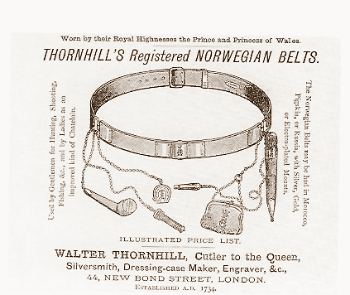
|
This month we present an 1881 advertisement of
WALTER THORNILL
Cutler to the Queen
Silversmith, dressing-case Maker, Engraver, &c.
44 New Bond Street, London
The announcement advertises the strange NORWEGIAN
BELTS "worn by their Royal Highnesses the Prince and
the Princess of Wales".
The belts could be used "by Gentlemen for Hunting,
Shooting, Fishing, &c., and by Ladies as an improved
kind of Chatelain".
|
"A WORD per MONTH"

|
BRITISH SILVER PLATE
ALPHABETIC SYMBOLS
The marks
of electroplated silver were often inspired to the
hallmarking used for sterling silver, but, unlike this
system, no codified rule was followed by silver plate
makers.
Nonetheless, besides the trade mark, many electroplaters
used alphabetic symbols to identify the town of origin,
the quantity of the silver used in plating and, in some
cases, the date of manufacture.
The purpose of these marks was, mostly, of promotional
nature and hid the unacknowledged goal of confusing the
customer about the nature of the metal alloy....
more
|
"A SILVERSMITH per MONTH"
|
|
ATKIN BROTHERS (SILVERSMITHS) LTD
Atkin Brothers business
traces his origin to Thomas Law, a silversmith active in
Sheffield from c. 1750 to 1775. He was one of the only
two firms combining the trades of cutlers and general
silversmiths.
The business was continued by his sons John and William,
and later by Joseph Law (probably the son of John, as in
an 1830 directory he is quoted as "Joseph Law, late John
Law & Son").
In 1824 was entered the mark of Jos. Law, Jn Oxley &
Henry Atkin (oddly the mark was "LL", possibly for Law &
Law) and in 1829 Henry Atkin and John Oxley, trading as
Atkin, Oxley & Co, succeeded to the original firm. They
dissolved their partnership c. 1840....
more
|
"A BOOK ON MY SHELF"
In this column we present books, new
or ancient, dealing with silver in all its aspects (history,
marks, oddities...). This isn't a "book review" but only a fair
presentation of some useful "tools" that anyone may have in the
shelf of his bookcase.
ASCAS members are invited to contribute to this column
(click to enlarge images)
The "book on my shelf" of this month presents:
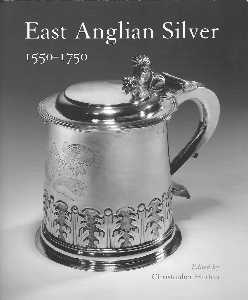
|
EAST ANGLIAN SILVER
1550-1750
edited by
Christopher Hartop
John Adamson - Cambridge
2004
The beauty of stunning craftsmanship of
silver made in East Anglia have long been
celebrated by scholars and collectors. This book
describes in depth a wealth of important silver
articles made in the region which are now to be
found in museums and private collections in
Britain, America and Australia, as well as in
churches in Norfolk, Suffolk and Essex. Many of
the objects featured have never been published
before, including a beaker in the Royal
Collection by Elizabeth Haslewood, Norwich's
only woman silversmith of the Stuart period, and
a magnificent Charles II tankard from the
Gregory Peck collection...
|
"A CREST per MONTH"
In this column we present images and
descriptions of Crests and Mottoes of British, Irish and
Scottish families as engraved on silver items.
ALEXANDER
DUPRE-ALEXANDER
ROW
WHETHAM
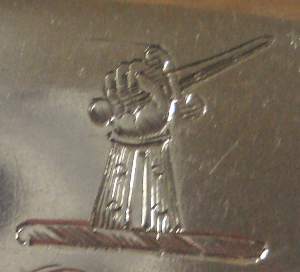
|
The crest of Alexander (many
families: Dublin, Kent, Caledonia, London of Scottish
descent), Dupre-Alexander, Row (Scotland), Whetham.
An arm, in armour, issuing, in hand a sword.
The crest was found in a silver spoon hallmarked London
1821, makers Sarah and John William Blake


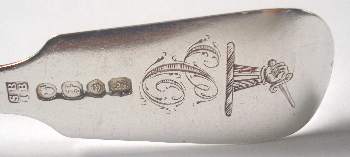
|
Closing our November 2010 edition of ASCAS
Newsletter I hope you have appreciated its content.
Your comments, suggestions and advice will be of great help.
My thanks to Jayshree Desai,
Jayne Dye, Piero Eduardo, Samantha Macnally, Robert Massart,
Lise Moor, Eddie Robinson, Les Salvage, Malcolm Stander, Haroune
Toumani for their invaluable contributions.
Giorgio Busetto
Secretary
DISCLAIMER AND PRIVACY POLICY
ASCAS is a community of people having a common
interest in antique silver.
It is a non-profit association without commercial links.
Membership is open to whomever has a true interest in
this subject matter.
ASCAS has no real property and no fees are requested nor
accepted from members.
ASCAS keeps in touch with its members only through
periodical newsletters, e-mails and web-site updating
and ignores and is not responsible for any other
activity pursued by its members.
Likewise, ASCAS is not responsible for opinions,
evaluation and images displayed, and in any form
published or supplied for publication, by its members
who, in any case, maintain the property of their works
and assure the respect of national and international
legislation about Intellectual Property.
ASCAS does not have the full addresses of its members (only
town, country and e-mail address are requested for
membership).
ASCAS handles and protects with care its members' e-mail
addresses, will not disclose the addresses to third
parties, will use this information only to reply to
requests received from members and for communications
strictly related to its activity.
These rules are expressly accepted by submitting the
membership request.
|
|
 newsletter
# 78 November 2010
newsletter
# 78 November 2010








